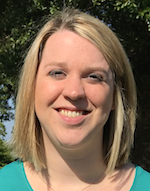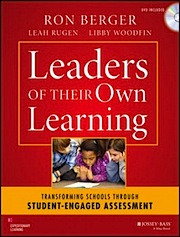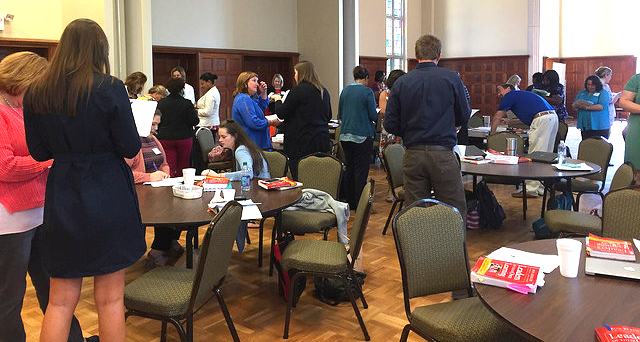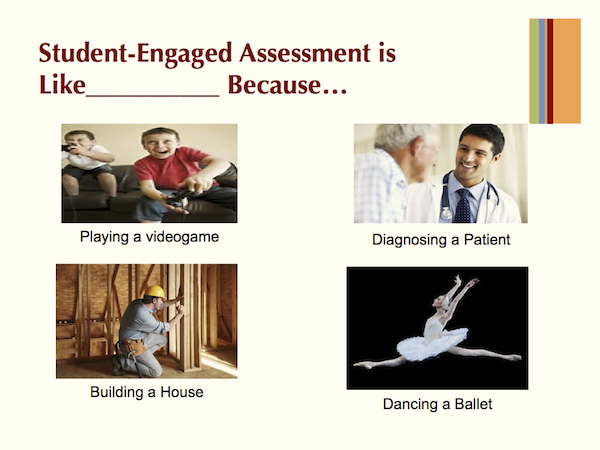NOTE: This post about the ‘reboot’ of ABPC’s Wiregrass+ PCN intersperses Cathy’s narrative with observations (in italics) from our newest staff member, program coordinator Emily Strickland. Welcome, Emily!
By Cathy Gassenheimer and Emily Strickland
 I’ve always been fascinated with time travel. Growing up, one of my favorite TV shows was the Time Tunnel. I’m also quick to devour books like The Time Machine, Time Traveler’s Wife, and other “chrono-literature” and wonder what it was like to go back in time (I’ve never been a fan of going forward!).
I’ve always been fascinated with time travel. Growing up, one of my favorite TV shows was the Time Tunnel. I’m also quick to devour books like The Time Machine, Time Traveler’s Wife, and other “chrono-literature” and wonder what it was like to go back in time (I’ve never been a fan of going forward!).
This summer during our annual planning time, I had an opportunity something akin to time travel when we decided to “restart” one of our Powerful Conversations Networks. Because of transitions and other changes, our “Wiregrass+ PCN” this year will be constituted mostly of educators new to ABPC networks. So it made sense to differentiate the professional learning for the folks joining this “new” network.
Reflecting on the possibilities, I traveled back in time – at least in my mind – to 2013 when we first introduced student-engaged assessment to our network colleagues.
Student-engaged assessment was developed by Ron Berger and colleagues at EL Education (formerly Expeditionary Learning) based on their many years of teaching and working with learners in environments within and without classroom walls.
Designed to shift the nexus of learning from the teacher to the student, student-engaged assessment puts students in the driver’s seat through the use of eight defined and common practices. This two-minute video captures that gist of the eight practices and student-engaged assessment.

Like Cathy, I’ve also always been interested in time travel. What she accomplished with this time travel is what almost every fictional time traveler strives to achieve, but usually fails to do. Time travel is not usually just for the sights of the past – the traveler has a specific goal in mind. The hero wants to change something or someone in order to make the future a better place. The Wiregrass+ PCN might have been going back in time, but most of us—me included— were experiencing it for the first time. We, the participants, were the goal. We must be inspired to create a brighter future.
It’s not often that one gets to rethink and repeat a process. So, as I began thinking about the possibilities, three important questions came to mind.
What if…
 We pushed the restart button for the Wiregrass+ PCN by starting anew with student-engaged assessment using the seminal book, Leaders of Their Own Learning, by EL Education?
We pushed the restart button for the Wiregrass+ PCN by starting anew with student-engaged assessment using the seminal book, Leaders of Their Own Learning, by EL Education?- We looked to the feedback we gathered back in 2013-2014 and adapted the professional learning based on what we learned then?
- We focused initially more on the “why” of student-engaged assessment instead of moving so quickly to the “how?”
And, with the enthusiastic support of participating members, we did push the restart button!
This was my very first PCN meeting and it felt truly fitting that it was also the restart since I am starting from the beginning myself. I got to sit with a group that was new to PCN as well, and throughout the day we all learned something from the meeting and from each other. I got to learn first hand some of the challenges Alabama educators face and watch the ideas highlighted in Leaders of their Own Learning begin to help guide them in a more positive direction.
The idea of student-engaged assessment can be intimidating if a school has large class sizes or has always used the traditional teacher instruction model. After watching a video clip of students demonstrating their self assessments on a variety of grade levels, some of the questions I began to hear were “How can we do this?” and “How can we trust the kids to keep up with their homework assignments?” or “Will we have enough time to help the students once they make their own assessments?” not to mention trying to work this model in around all the standards already in place in a school.
Begin with a brain-dump!
On the day of our recent first meeting, Lori Snell – who co-facilitated the session with me – and I had high expectations for the day, but we were still a bit nervous.
We began the day with a four-box synectic, where we asked participants to first do a “brain-dump” about their knowledge of student-engaged assessment. After their quick-write, they were asked to compare their knowledge of student-engaged assessment to one of four similes shown in this slide.
The creative juices started flowing as educators starting making connections such as: Student-engaged assessment is like a videogame because both short-term and longer-term goals are set and immediate feedback is applied. Or, student-engaged assessment is like diagnosing a patient because feedback like a patient’s temperature, blood pressure, and heart rate provides vital information to the doctor.
The four-box synectic had us hearing participants comparing student-engaged assessment to a video game because the teachers want the kids to “own their assessment” to try to reach that next level of achievement. They want the students to be as enthusiastic and knowledgeable about what they need to improve in the classroom as they are about learning from their mistakes in a game. Putting it in these terms is simple enough to understand but still the question lingers, how do we do that?
Participants were engaged but they wanted to know more about “how” to move forward. Recognizing the mistake we had made four years previously, we kept them in suspense a while longer.
Before there can be an answer to how, we had to first understand why it was so important. It all began to come together when the participants started to think about the learning targets in their own school. After discussing this and unpacking what they have done in their classrooms and after reading suggestions and examples from the book, they were able to piece together, beyond their previous understandings, why learning targets are important to student-engaged assessment and how much reflection and revision can help both their students and themselves.
Moving forward, we showed them a short video where students were discussing the value of student-engaged assessment and how it enabled them to be more engaged in their learning by honing in on those skills with which they were struggling. After watching the video, participants used the “See, Think, Wonder Protocol” to discuss their insights and identify their reasons for using student-engaged assessment.
I began to hear things like “saying the kids can help play a role in revising the learning target doesn’t mean letting them write it – it means revising the wording in the target to make sure they understand what they are going to be learning” and “the learning targets give kids their own language to understand what’s going on in the class”. The fear was subsiding. The attitude went from thinking that giving the kids their own power is too great of a responsibility to thinking that giving the kids their own power is the only thing that really makes sense if we want them to learn the material.
Participants next took a “deep dive” into learning targets by investigating “what’s, why’s, and how’s.” After dipping into the text, followed by extensive discussion, PCN members were treated to one last video—this time showing a teacher actively using a learning target to ensure student understanding and engagement.
Now, we are ready for the “how.”
It just took the participants going back in time in their own minds to bridge together the importance of the “why” before the “how”. Kind of like how you have to have your students buy into the idea of self-assessment before you can implement ways to teach them how to do that. Sometimes you have to go backward to go forward. Which just proves that if we as adults learn from self-reflection and assessment – shouldn’t we trust our students to be able to do the same?
Cathy Gassenheimer is Executive Vice President for the Alabama Best Practices Center. She joined the A+ Education Partnership in 1991, and in 1999 led the creation of the ABPC which today works directly with educators through four statewide professional learning networks, including the Powerful Conversations Network (school teams). Follow her on Twitter @cathygassenheim.
Emily Strickland is ABPC’s new Program Coordinator. A native of Montgomery, she attended Saint James School from kindergarten through graduation and still talks to her best friends from primary school every day. In 2012, she earned a bachelor’s degree in English from Auburn University and has worked for nonprofits for the past five years. Reach her via email at [email protected].



0 Comments on "PCN Time Travel! Starting Over, With the Why Before the How"